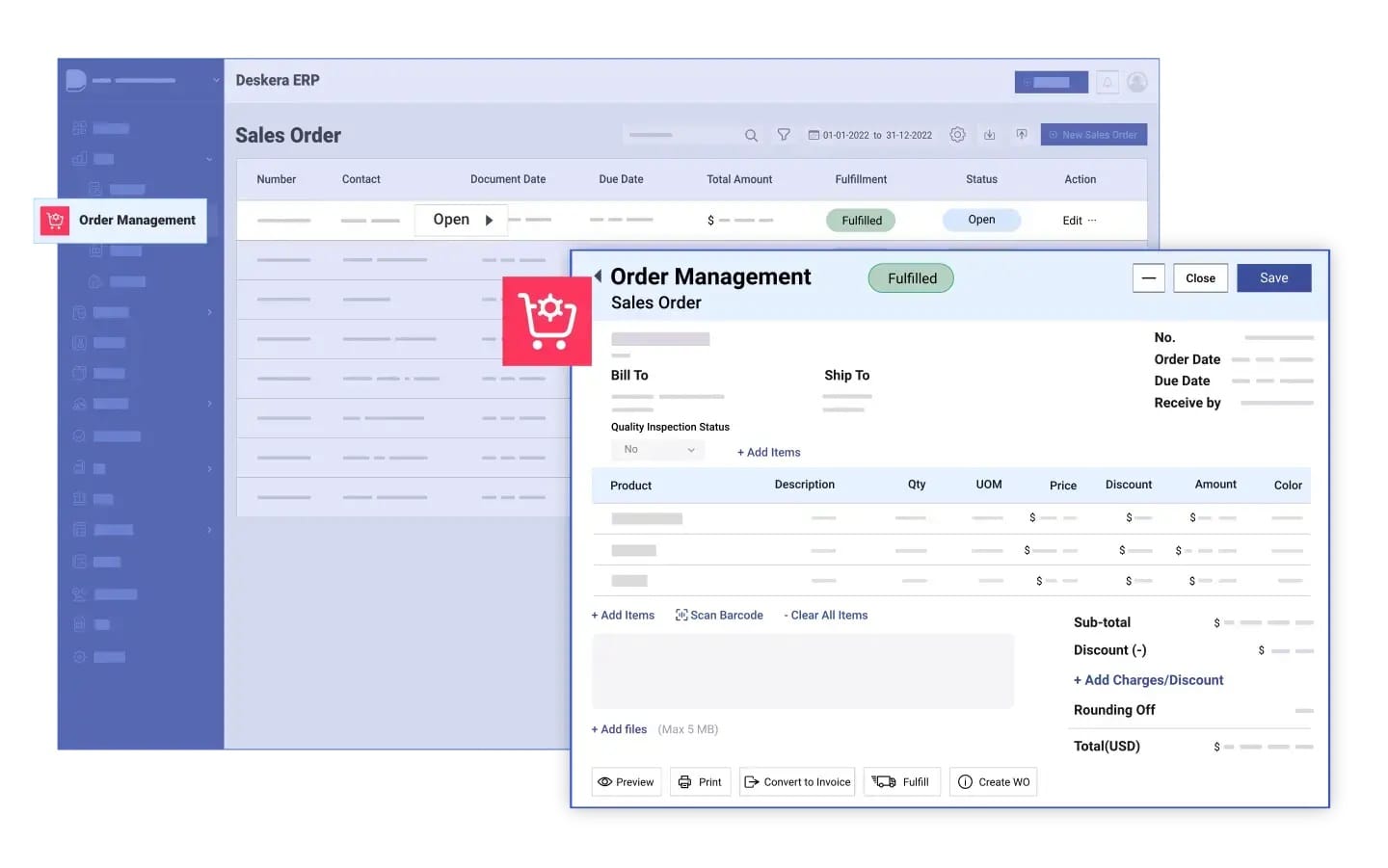Effective order management is the backbone of any successful business, ensuring that customer orders are processed accurately and efficiently. As companies scale, managing orders manually becomes increasingly difficult, leading many to adopt digital solutions.
In fact, the global order management software market was valued at $2.95 billion in 2023 and is projected to grow to $3.17 billion by 2030, highlighting the rising demand for streamlined order management systems.
As businesses grow, the complexity of handling customer orders, managing stock levels, and coordinating with suppliers can overwhelm traditional processes. This is where advanced order management software plays a pivotal role, automating tasks and integrating with other business systems like work order software and CRMs.
Whether you're dealing with large-scale manufacturing or small business operations, having a unified order management system not only reduces errors but also enhances customer satisfaction by ensuring orders are processed quickly and accurately.
With the rise of digital tools like Salesforce order management, companies can now access a scalable, cloud-based platform that supports everything from order tracking to fulfillment in real time. Businesses can gain a competitive edge by adopting such technologies, improving their ability to meet market demands while reducing operational inefficiencies.
A robust order management system can automate everything from inventory tracking to customer fulfillment, optimizing the entire order management process.
Tools like Deskera ERP provide businesses with an all-in-one solution, offering modules for work order management, purchase order management, and real-time inventory tracking.
With Deskera’s customizable features, businesses can improve operational efficiency while gaining detailed insights into each phase of the supply chain.
What is Order Management?
Order management refers to the process of efficiently handling and tracking customer orders from the initial placement to final delivery. It encompasses every step in the order lifecycle, including order creation, inventory management, order processing, fulfillment, and after-sales services like returns or exchanges.
An effective order management process ensures that orders are fulfilled accurately and on time, minimizing errors and enhancing customer satisfaction.
By utilizing an order management system (OMS), businesses can automate and streamline these tasks, allowing for real-time visibility into inventory, improved coordination across departments, and faster order processing.
Whether integrated with work order management systems or linked to purchase order management tools, an OMS plays a crucial role in optimizing supply chain efficiency and supporting seamless operations in businesses of all sizes.
What is an Order Management System (OMS)?
An order management system (OMS) is a digital platform designed to manage the entire lifecycle of an order, from when it's placed by a customer to its fulfillment and delivery.
The system automates key functions such as order tracking, inventory management, order processing, and post-sale services like returns and exchanges. By centralizing these activities, an OMS helps businesses streamline their order management process, reduce manual errors, and improve overall operational efficiency.
In addition to handling customer orders, an OMS often integrates with other tools like work order management systems and purchase order management software to create a unified approach to managing both internal and external order workflows.
By providing real-time visibility into inventory levels and order statuses, the system enables businesses to meet customer demands quickly, ensuring timely deliveries and enhancing customer satisfaction.
Key Features and Functionality of an Order Management System (OMS)
An order management system (OMS) offers a range of features that help businesses automate and streamline their order-related processes. Here are some of the key features and functionalities of an OMS:
1. Centralized Order Processing
- An OMS consolidates orders from multiple sales channels (e.g., online stores, physical locations, marketplaces) into one platform. This allows for seamless management and tracking of orders, improving efficiency and minimizing errors.
2. Real-Time Inventory Management
- The system provides real-time visibility into inventory levels, helping businesses avoid stock outs or overstock situations. It tracks inventory across multiple warehouses and locations, ensuring accurate fulfillment.
3. Automated Order Routing and Fulfillment
- With built-in automation, an OMS routes orders to the appropriate fulfillment center based on location, stock availability, or shipping preferences. This speeds up order processing and delivery.
4. Multi-Channel Integration
- An OMS integrates with multiple sales channels and platforms (e.g., e-commerce, marketplaces, CRM) for a unified order management process. This ensures consistency across all customer touchpoints.
5. Returns and Refund Management
- The system manages returns, exchanges, and refunds, automating the process to enhance customer satisfaction and minimize the burden on support teams. This also includes tracking reverse logistics for returned products.
6. Customer Order Tracking
- An OMS offers real-time order tracking for customers, providing updates on the status of their orders, shipment details, and delivery timelines. This transparency improves the overall customer experience.
7. Reporting and Analytics
- Businesses can generate reports on sales performance, inventory turnover, fulfillment times, and other key metrics. These insights help businesses optimize their operations and make data-driven decisions.
8. Order Prioritization and Workflow Management
- An OMS allows businesses to prioritize urgent or high-value orders, automating workflows to ensure timely processing. It can also handle complex orders involving customization or bundling of products.
9. Integration with Work Order and Purchase Order Management Systems
- Seamlessly integrates with work order management and purchase order management software to track internal and supplier-related orders, improving supply chain coordination.
10. Scalability
- As businesses grow, an OMS scales to handle larger volumes of orders and more complex processes, ensuring that operations remain efficient even during periods of high demand.
These features collectively ensure that an OMS optimizes the entire order management process, from receiving orders to fulfillment and post-sale services, resulting in greater efficiency and enhanced customer satisfaction.
How an Order Management System (OMS) Streamlines Order Processes
An order management system (OMS) plays a vital role in streamlining and automating the complex steps involved in the order management process, helping businesses operate more efficiently.
Here’s how an OMS improves the overall flow of orders:
1. Centralized Order Handling Across Channels
By integrating multiple sales channels into one unified platform, an OMS simplifies the management of orders from different sources—whether from e-commerce websites, physical stores, or marketplaces. This centralized approach reduces manual errors and ensures consistency across all customer interactions.
2. Real-Time Inventory Visibility
With real-time tracking and updates, an OMS provides accurate insights into inventory levels across various warehouses. This prevents issues such as overstocking or stockouts and helps optimize purchase order management, ensuring that products are always available when needed.
3. Automation of Routine Tasks
An OMS automates several critical tasks, such as order routing, processing, and fulfillment, saving time and reducing the risk of manual mistakes. For example, orders are automatically directed to the closest warehouse for faster shipping, improving the speed and efficiency of the fulfillment process.
4. Integration with Work Order and Purchase Order Systems
For companies with internal production or procurement processes, the integration of an OMS with purchase order management software helps synchronize all stages of the order lifecycle. This seamless integration leads to better coordination across teams, reducing delays and improving overall productivity.
5. Enhanced Customer Experience with Real-Time Tracking
With an OMS, customers can easily track their orders in real time, from placement to delivery. This transparency boosts customer satisfaction by keeping them informed throughout the entire process, minimizing inquiries and complaints.
6. Improved Return and Exchange Management
Handling returns, exchanges, and refunds can be a challenge for many businesses. An OMS streamlines these processes by automating workflows for managing reverse logistics. This makes the post-sale experience smoother for both businesses and customers.
By leveraging the key features of an order management system, businesses can optimize their workflows, reduce inefficiencies, and enhance both the customer experience and internal operations. Whether integrating with work order software, an OMS ensures smooth and reliable order processing at every stage.
Benefits of an Order Management System (OMS)
An order management system (OMS) provides businesses with numerous advantages, enhancing their ability to process orders efficiently and improve customer satisfaction.
Here are some of the key benefits of implementing an OMS:
1. Increased Efficiency and Automation
One of the primary benefits of an OMS is the automation of various tasks within the order management process. This includes automating order routing, inventory updates, and customer notifications, significantly reducing manual efforts and human errors. By streamlining these tasks, businesses can process more orders in less time.
2. Real-Time Inventory Management
An OMS offers real-time visibility into inventory levels across multiple locations, ensuring accurate tracking of available stock. This prevents over-ordering, stockouts, and delays in fulfillment, enabling businesses to better manage their purchase order management and inventory replenishment processes.
3. Centralized Multi-Channel Order Processing
With an OMS, businesses can handle orders from various sales channels—whether online, in-store, or through third-party marketplaces—within one centralized system. This ensures consistency across platforms and improves coordination between sales, customer service, and fulfillment teams.
4. Enhanced Customer Experience
Providing customers with real-time order tracking and notifications improves transparency and satisfaction. An OMS ensures that customers receive timely updates about their orders, shipping status, and delivery times, enhancing overall customer service and customer loyalty.
5. Reduced Operational Costs
By automating routine tasks and minimizing errors, an OMS helps reduce operational costs. Fewer mistakes in order processing mean fewer returns, refunds, and customer complaints, ultimately saving businesses money. The system also optimizes resource allocation, ensuring that warehouses and teams operate efficiently.
6. Better Reporting and Analytics
An OMS provides businesses with detailed insights and analytics on sales performance, order fulfillment times, inventory turnover, and other key metrics. This data enables companies to make informed decisions, optimize their order management system, and improve long-term operational strategies.
7. Seamless Integration with Other Systems
An OMS can easily integrate with other essential business tools, such as work order management systems, purchase order management software, and ERP solutions like Salesforce order management. This creates a unified approach to managing every aspect of the order lifecycle, from procurement to fulfillment.
8. Improved Scalability
As businesses grow, an OMS scales to accommodate increasing order volumes, new sales channels, and more complex processes. This scalability ensures that businesses can expand without being limited by their order management capabilities.
By incorporating an order management system, businesses can boost operational efficiency, enhance customer satisfaction, and position themselves for long-term success.
Whether integrated with work order software or Salesforce order management, the benefits of an OMS extend across all facets of the order fulfillment process.
Steps in the Order Management Process
The order management process involves a series of steps that ensure customer orders are fulfilled accurately and efficiently, from the moment an order is placed to its final delivery.
Below are the key stages in this process:
1. Order Placement
The process begins when a customer places an order through various sales channels, such as an e-commerce website, physical store, or third-party marketplace. An order management system (OMS) consolidates orders from all these platforms into a central hub for easier tracking and management.
2. Order Processing
Once an order is placed, the system verifies product availability by checking current inventory levels in real time. At this stage, payment authorization is completed, and the order is confirmed. If any issues arise, such as insufficient stock, the customer is notified, and the order is either modified or canceled.
3. Inventory Management
After confirming the order, the OMS updates inventory levels to reflect the stock allocated for the order. This step ensures real-time tracking of available products across multiple warehouses and locations. Effective inventory management is crucial in preventing stockouts and overstock situations.
4. Order Fulfillment
The next step is to fulfill the order by selecting the most efficient warehouse or fulfillment center based on stock availability and customer location. The order is then packed and prepared for shipment. In advanced systems, work order management can also be integrated to ensure smooth internal workflows for complex products.
5. Shipping and Delivery
After fulfillment, the order is shipped using the chosen delivery method. The OMS automatically generates tracking information and sends it to the customer, allowing them to monitor the shipment's progress. This step ensures a transparent delivery process, which helps improve customer satisfaction.
6. Order Tracking and Notifications
Throughout the shipping process, customers receive real-time updates on the status of their orders, including estimated delivery times. The OMS handles this communication by integrating with carriers and notifying customers of any changes or delays.
7. Returns and Exchanges
The order management process doesn't end with delivery. If the customer needs to return or exchange the product, the OMS facilitates this by managing reverse logistics. It tracks return requests, processes refunds or exchanges, and updates inventory to reflect the returned stock.
8. Post-Sale Reporting and Analytics
The final step involves analyzing the order's performance. Using data collected throughout the process, businesses can generate reports on key metrics like fulfillment times, sales trends, and inventory turnover. These insights allow companies to optimize future order management processes and make data-driven decisions.
These steps ensure a smooth and efficient order flow, with the order management system serving as the backbone to automate and optimize each stage. From order placement to post-sale analytics, a robust OMS is essential for enhancing customer satisfaction and streamlining operations across the entire supply chain.
Challenges in Order Management and Solutions Using Order Management Tools
Managing orders efficiently can be a complex task, especially as businesses grow and deal with higher volumes and multiple sales channels.
Below are some common challenges in the order management process and how order management systems (OMS) help overcome these issues:
1. Inaccurate Inventory Levels
- Challenge: One of the biggest challenges is maintaining accurate inventory records, especially when handling multiple sales channels or warehouses. Stock discrepancies can lead to overselling or stockouts, impacting customer satisfaction.
- Solution: An OMS provides real-time inventory tracking, ensuring that businesses have up-to-date information on stock availability across all locations. This helps prevent overselling and enables better purchase order management for replenishment.
2. Manual Order Processing Errors
- Challenge: Relying on manual data entry for order processing increases the likelihood of human errors, such as incorrect orders, missed items, or incorrect shipping details.
- Solution: Automating order workflows with an order management system reduces the chance of human error. The system automates order validation, routing, and fulfillment processes, ensuring accuracy at every stage.
3. Handling Orders Across Multiple Sales Channels
- Challenge: Businesses selling across various platforms (e.g., online stores, marketplaces, physical locations) often struggle to manage orders efficiently. Manually consolidating orders from different platforms can lead to delays and errors.
- Solution: An OMS integrates with multiple sales channels, consolidating all orders into a single dashboard. This centralization simplifies the management of orders from various sources, allowing businesses to process them in a streamlined manner.
4. Slow Order Fulfillment and Delayed Deliveries
- Challenge: Delayed order fulfillment due to inefficient processes or poor warehouse coordination can lead to customer dissatisfaction and loss of sales.
- Solution: An OMS automates the fulfillment process by selecting the most appropriate warehouse or fulfillment center, based on stock availability and customer location. This speeds up the picking, packing, and shipping processes, ensuring faster deliveries.
5. Inefficient Return Management
- Challenge: Handling returns and exchanges manually can be time-consuming and error-prone, often leading to unhappy customers and lost revenue.
- Solution: An OMS manages the entire returns process, from tracking return requests to processing refunds or exchanges. It also updates inventory in real-time to account for returned products, improving reverse logistics management.
6. Lack of Visibility into Order Status
- Challenge: Without a transparent tracking system, customers often experience frustration when they can't easily check the status of their orders, leading to increased customer service inquiries.
- Solution: An OMS offers real-time order tracking, allowing both businesses and customers to monitor the status of orders from placement to delivery. This transparency enhances customer satisfaction and reduces the burden on support teams.
7. Scaling with Business Growth
- Challenge: As a business grows, handling a higher volume of orders, complex workflows, and more channels can overwhelm existing systems and processes, leading to bottlenecks.
- Solution: An order management system is scalable and can handle increasing order volumes, more sales channels, and complex operations. The system grows with the business, ensuring that order processes remain efficient even during periods of high demand.
By addressing these challenges with the right order management tools, businesses can streamline their operations, improve order accuracy, and ultimately enhance customer satisfaction.
The integration of work order software and purchase order management systems further ensures that all stages of the order process, from procurement to delivery, are optimized for efficiency.
Optimizing the Order Management Process: Best Practices for Seamless Operations
Implementing best practices in the order management process can significantly enhance efficiency and reduce the risk of errors. By leveraging the capabilities of order management software, businesses can streamline their operations and automate time-consuming tasks.
Here are some essential best practices and how order management systems (OMS) play a crucial role in automating processes:
1. Centralize Orders Across All Channels
- Best Practice: Integrate all sales channels into one unified system to ensure that orders from e-commerce, physical stores, and third-party platforms are handled consistently.
- Automation Solution: An OMS consolidates orders from multiple sources into a single dashboard. This integration minimizes manual intervention and reduces errors, providing a seamless experience for both customers and employees.
2. Real-Time Inventory Tracking
- Best Practice: Maintain real-time visibility into inventory across all locations to avoid stockouts and ensure that products are always available when customers place an order.
- Automation Solution: The OMS automatically updates inventory levels as orders are placed, processed, and fulfilled. This real-time tracking reduces discrepancies, optimizes purchase order management, and ensures accurate stock levels.
3. Automate Order Routing and Fulfillment
- Best Practice: Automate the process of routing orders to the nearest or most efficient warehouse or fulfillment center based on stock availability and customer location.
- Automation Solution: An OMS automates order routing and fulfillment by selecting the optimal location for shipping. This ensures faster delivery times and minimizes shipping costs, enhancing the overall customer experience.
4. Streamline Return Management
- Best Practice: Implement a clear and automated process for managing returns, refunds, and exchanges to improve customer satisfaction and reverse logistics.
- Automation Solution: The OMS automates return processes by tracking return requests, processing refunds, and updating inventory. This reduces manual workload and simplifies reverse logistics, leading to faster resolutions for customers.
5. Leverage Data Analytics for Continuous Improvement
- Best Practice: Use data analytics to monitor key performance indicators (KPIs) such as order processing times, fulfillment accuracy, and customer satisfaction.
- Automation Solution: An order management system provides detailed reports and real-time analytics on all aspects of the order management process. These insights allow businesses to identify areas for improvement, optimize workflows, and make data-driven decisions.
6. Integrate with Work Order and Purchase Order Systems
- Best Practice: Integrate your work order management system and purchase order management software with your OMS for seamless operations across procurement, production, and fulfillment.
- Automation Solution: The integration of these systems ensures that all steps in the order lifecycle, from procurement to fulfillment, are synchronized, reducing delays and increasing efficiency.
7. Prioritize Customer Communication
- Best Practice: Keep customers informed about the status of their orders, from placement to delivery, through automated notifications and real-time tracking.
- Automation Solution: An OMS automates customer communication by sending real-time updates about order progress, shipping status, and expected delivery times. This enhances transparency and improves customer satisfaction.
By following these best practices and utilizing the automation capabilities of order management software, businesses can streamline their order management process, reduce operational costs, and provide a seamless experience for customers.
Whether it's integrating Salesforce order management or automating work order software, the right OMS helps businesses stay agile and efficient in a competitive market.
Types of Order Management Software
Order management software (OMS) comes in different types, catering to the varying needs of businesses depending on their size, industry, and sales channels. These solutions help businesses streamline their order management process, handle orders across multiple platforms, and manage complex workflows.
Below are the main types of order management software available:
1. Standalone Order Management Software
- Overview: This type of software is dedicated solely to managing orders. It is typically used by smaller businesses that need a simple, cost-effective solution to track, process, and fulfill customer orders.
- Best For: Small businesses or startups with a limited number of sales channels.
- Key Features: Order tracking, basic inventory management, order fulfillment, and customer notifications.
2. Integrated Order Management Software
- Overview: Integrated OMS solutions are part of a broader software suite that connects with other business functions such as inventory, warehouse management, and accounting systems. These are designed for businesses with more complex workflows that require all processes to be in sync.
- Best For: Medium to large enterprises needing a unified system for order, inventory, and financial management.
- Key Features: Seamless integration with ERP systems, real-time inventory management, multi-channel support, and analytics.
3. Cloud-Based Order Management Software
- Overview: Cloud-based order management software is hosted on the internet, allowing businesses to access the system from anywhere. These solutions offer scalability, making them ideal for growing businesses that need flexibility.
- Best For: Businesses of all sizes, especially e-commerce companies and those with remote teams or multiple locations.
- Key Features: Real-time data access, automatic updates, scalability, and integration with other cloud applications.
4. Enterprise Resource Planning (ERP) Systems with OMS
- Overview: Some ERP systems come with integrated order management modules. These systems manage the entire business process, from order placement to procurement, inventory, and fulfillment, in one platform.
- Best For: Large organizations with complex, end-to-end operational needs.
- Key Features: Advanced inventory control, financial management, work order management, and seamless integration across departments.
5. E-commerce Order Management Software
- Overview: Tailored specifically for online retailers, this type of order management software integrates with popular e-commerce platforms such as Shopify, WooCommerce, and Amazon. It automates the entire order-to-delivery cycle for e-commerce businesses.
- Best For: E-commerce businesses managing high-volume orders from multiple online platforms.
- Key Features: Multi-channel order tracking, integration with shipping carriers, real-time inventory updates, and returns management.
6. Warehouse Management Systems (WMS) with OMS Capabilities
- Overview: Some warehouse management systems (WMS) include order management features that integrate inventory, procurement, and shipping processes. These are ideal for companies that need detailed tracking and control over their warehouse operations.
- Best For: Manufacturing companies or businesses with extensive warehousing operations.
- Key Features: Order picking, packing, shipping management, real-time inventory tracking, and warehouse automation.
7. Hybrid OMS Solutions
- Overview: Hybrid OMS combines on-premise and cloud-based features, offering businesses the flexibility to manage orders both offline and online. These systems are designed for companies that need robust order management with cloud connectivity and on-premise security.
- Best For: Businesses with specific regulatory requirements or those looking for a blend of online and offline order management capabilities.
- Key Features: Real-time data synchronization, flexible deployment options, and multi-channel support.
These different types of order management systems allow businesses to choose the right solution based on their operational needs, budget, and scalability. Whether it's a simple standalone OMS or a complex ERP-integrated order management system, selecting the right tool helps businesses improve efficiency, customer satisfaction, and overall order accuracy.
What is Salesforce Order Management?
Salesforce order management is a cloud-based solution that integrates seamlessly with Salesforce's existing CRM and e-commerce tools, allowing businesses to manage orders across multiple sales channels and fulfillment centers.
This software centralizes all order-related information, automating workflows, and offering a unified platform for tracking orders, inventory, and customer interactions.
Whether it's capturing an order, managing returns, or keeping customers informed, Salesforce’s order management software ensures that the entire process is efficient and transparent.
Features and Functionalities of Salesforce’s Order Management Software
Salesforce’s order management system is equipped with powerful features that cater to businesses of all sizes. Here are some of the key functionalities:
- Omnichannel Order Capture: Salesforce allows businesses to capture orders from multiple sales channels, including e-commerce platforms, physical stores, and mobile apps. The system consolidates orders in a centralized dashboard, making it easier to manage high volumes of orders across different platforms.
- Automated Fulfillment Workflows: The system automates the entire fulfillment process by routing orders to the appropriate warehouse or fulfillment center based on product availability and customer location. This ensures faster order processing and delivery.
- Real-Time Inventory Management: Salesforce provides real-time updates on inventory levels, preventing stock outs or overselling. The system ensures that inventory data is accurate across all channels, helping businesses optimize purchase order management and reduce overstock.
- Advanced Shipping and Returns Management: Salesforce streamlines the shipping process by integrating with major shipping carriers, automating label generation, and providing real-time tracking information. Additionally, the system simplifies returns management, helping businesses process refunds or exchanges efficiently.
- Customer Communication and Self-Service: Salesforce Order Management enables businesses to keep customers informed about their order status with automated notifications. It also offers a self-service portal where customers can track orders, initiate returns, and manage their account preferences.
- Customizable Order Lifecycle: The system allows businesses to customize each stage of the order management process based on their unique workflows. This flexibility ensures that the software can adapt to the specific needs of various industries and business models.
How Salesforce Order Management Integrates with Other CRM Tools
One of the key advantages of Salesforce order management is its seamless integration with Salesforce’s broader suite of CRM tools, including Sales Cloud, Service Cloud, and Commerce Cloud.
This integration allows businesses to manage customer interactions, sales processes, and order fulfillment within a unified system, creating a cohesive experience for both customers and employees.
- Sales Cloud Integration: Salesforce order management integrates with Sales Cloud, allowing sales teams to have full visibility into customer orders and inventory levels. This integration enables sales representatives to offer better service by tracking order progress and providing real-time updates to customers.
- Service Cloud Integration: By integrating with Service Cloud, businesses can manage customer service cases related to orders, such as tracking shipments or processing returns, all from one platform. Customer service teams can access all order-related information, helping them resolve issues quickly.
- Commerce Cloud Integration: Salesforce Order Management works in tandem with Commerce Cloud, enabling businesses to synchronize e-commerce transactions with order fulfillment processes. This integration is essential for businesses looking to provide a consistent shopping experience across multiple digital channels.
Advantages of Using Salesforce for Order Management
1. Unified Customer Experience
Salesforce order management provides a comprehensive view of the entire customer journey, from product discovery to post-purchase interactions.
By unifying order data with customer data from the CRM, businesses can offer personalized experiences, resolve issues quickly, and maintain a consistent level of service across all touchpoints.
2. Scalability for Businesses of All Sizes
Whether you are a small business just starting or a large enterprise managing thousands of orders daily, Salesforce order management is highly scalable.
The cloud-based system grows with your business, allowing you to add new sales channels, warehouses, and fulfillment options without the need for significant infrastructure changes.
3. Advanced Reporting and Analytics
Salesforce order management offers robust reporting and analytics tools that provide insights into key performance indicators (KPIs) such as order processing times, fulfillment accuracy, and customer satisfaction.
With these insights, businesses can make data-driven decisions to optimize their operations and improve customer service. Additionally, the system allows businesses to forecast demand, helping to better manage inventory and fulfillment strategies.
How to Implement an Effective Order Management System
Implementing an effective order management system (OMS) can transform the way businesses handle their orders, inventory, and customer interactions. A well-executed OMS ensures streamlined operations, increased efficiency, and improved customer satisfaction.
Below is a step-by-step guide on how to implement a robust order management system that aligns with your business needs:
1. Assess Your Business Requirements
Before choosing an OMS, it's crucial to evaluate your existing order management process and identify pain points.
Consider factors like the volume of orders, the number of sales channels, inventory complexity, and customer service needs.
Understanding these requirements will help you select the right order management software tailored to your business.
- Questions to Ask:
- How many sales channels do you manage?
- What are your current order processing challenges?
- How integrated is your current system with other business operations?
2. Choose the Right Order Management Software
Selecting the right order management software is key to optimizing your operations.
There are various types of order management systems, from standalone software to ERP-integrated solutions, so it's important to choose one that best suits your business size and needs.
Look for features such as work order management, real-time inventory tracking, multi-channel support, and automation capabilities.
- Key Features to Consider:
- Omnichannel order management
- Integration with other systems like CRM, ERP, and warehouse management
- Real-time data visibility and inventory control
- Automated workflows for fulfillment, shipping, and returns
3. Ensure Seamless Integration
An effective OMS needs to integrate smoothly with your existing systems, such as e-commerce platforms, CRM tools, and ERP software.
Integration ensures data flows freely across departments, giving your teams access to real-time information for better decision-making.
By integrating your OMS with tools like Salesforce, you can have a unified view of customer interactions, inventory, and orders.
- Systems to Integrate:
- E-commerce platforms (e.g., Shopify, Magento)
- Accounting and finance systems
- Shipping carriers and warehouse management software
4. Automate Key Processes
Automation is a critical component of any effective OMS. Automating tasks like order entry, inventory updates, fulfillment workflows, and customer notifications will reduce manual errors, save time, and boost overall efficiency.
Use order management tools to automate key stages, such as order routing to the nearest warehouse, generating shipping labels, and triggering customer emails at every stage of the order lifecycle.
- Processes to Automate:
- Order routing and fulfillment
- Shipping and tracking
- Inventory updates across channels
5. Train Your Team
Even the most advanced order management system can fail if your team isn’t adequately trained.
Make sure all departments involved—sales, customer service, warehouse, and finance—are familiar with the system's features and understand how to use it.
Offer comprehensive training to ensure employees can efficiently handle new orders, manage inventory, and address customer queries using the OMS.
- Training Tips:
- Provide role-specific training sessions
- Create user manuals and documentation for quick reference
- Offer ongoing support and training refreshers as needed
6. Monitor and Optimize the System
After implementing your order management system, it's essential to monitor its performance regularly.
Use reporting and analytics features to track key metrics, such as order fulfillment times, error rates, and customer satisfaction.
This data will help you identify areas that need improvement and make necessary adjustments to optimize your process further.
- Key Metrics to Track:
- Order processing times
- Fulfillment accuracy
- Inventory turnover rates
- Customer satisfaction and return rates
7. Focus on Scalability
As your business grows, your order management system should be able to scale with it.
Choose a flexible and scalable OMS that can accommodate increased order volumes, additional sales channels, and new fulfillment centers without compromising performance.
Opt for a cloud-based or hybrid system that allows you to expand your operations seamlessly without costly infrastructure changes.
- Scalability Considerations:
- Ability to add new sales channels and locations
- Real-time data updates across a growing network
- Capacity to handle increased inventory and order volumes
By following these steps, you can successfully implement an effective order management system that enhances your business's efficiency, accuracy, and customer service.
A well-implemented OMS helps streamline your order processes, automate workflows, and ensure seamless integration across your systems, ultimately driving growth and improving customer satisfaction.
Future Trends of Order Management Systems
As businesses strive to stay competitive in a rapidly evolving marketplace, order management systems (OMS) are continuously advancing to meet new demands.
From AI-driven automation to omnichannel integration, the future of order management is focused on enhancing efficiency, customer experience, and flexibility.
Here are the top trends shaping the future of order management systems:
1. AI and Machine Learning Integration
One of the most transformative trends in order management software is the integration of artificial intelligence (AI) and machine learning (ML). These technologies enable OMS to predict customer behaviors, optimize inventory management, and improve decision-making.
AI-powered systems can analyze historical data to anticipate demand surges, minimize stockouts, and automatically route orders to the most efficient fulfillment centers. Additionally, AI chatbots and virtual assistants will enhance customer service, providing real-time assistance and order tracking updates.
- Example: AI-driven demand forecasting to ensure the right products are in stock based on historical purchase trends and market factors.
2. Omnichannel Order Fulfillment
As customer expectations evolve, businesses need to offer a seamless shopping experience across multiple platforms, from online stores to brick-and-mortar locations.
Omnichannel order management is becoming a standard feature, allowing companies to manage orders from various channels—e-commerce, in-store, and mobile—within a single system.
This trend ensures that businesses can provide flexible fulfillment options, including in-store pickup, same-day delivery, or shipping from the nearest warehouse.
- Example: Customers can order online and pick up in-store or choose different delivery options based on their preferences, with real-time inventory visibility across channels.
3. Cloud-Based Order Management Systems
Cloud technology is revolutionizing how businesses manage their operations. Cloud-based order management systems provide greater flexibility, scalability, and accessibility.
These systems enable businesses to manage orders from any location, collaborate in real-time across teams, and integrate seamlessly with other cloud-based tools like CRM and ERP platforms.
The trend toward cloud adoption ensures that companies can scale their order management processes without investing in costly infrastructure.
- Benefits: Scalability, faster deployment, real-time updates, and lower upfront costs for small and medium-sized enterprises (SMEs).
4. Automation and Robotics in Fulfillment Centers
Automation in warehouses and fulfillment centers is rapidly advancing with the use of robotics, conveyor systems, and automated storage and retrieval systems (AS/RS). OMS solutions are becoming increasingly integrated with these automation tools, allowing for faster and more accurate order processing.
Robotics can pick, pack, and ship orders with minimal human intervention, reducing fulfillment times and costs. The use of automated order management software ensures businesses can meet growing demand while maintaining efficiency.
- Example: Robots autonomously pick products from warehouse shelves based on real-time orders, increasing fulfillment speed.
5. Real-Time Data and Advanced Analytics
As businesses aim to stay ahead of market trends, having access to real-time data is critical. Future OMS will rely heavily on advanced analytics to provide insights into customer behavior, order trends, and inventory levels.
Businesses will use predictive analytics to make data-driven decisions, forecast demand, and optimize inventory management. Real-time data will help companies monitor performance metrics, such as order processing times and fulfillment accuracy, to improve overall efficiency.
- Use Case: Retailers analyzing real-time sales data to predict peak order times and optimize staffing levels during high-demand periods.
6. Blockchain for Transparent and Secure Transactions
Blockchain technology is expected to play a significant role in the future of order management systems by providing greater transparency and security in the supply chain. With blockchain, businesses can create tamper-proof records of every order transaction, from purchase to fulfillment.
This technology ensures that all parties, including suppliers, customers, and shippers, have access to an immutable and transparent record of the order journey. Blockchain will enhance trust and traceability, especially for industries where product authenticity and compliance are critical.
- Example: Using blockchain to track the journey of a product from manufacturer to customer, ensuring transparency and reducing the risk of fraud.
7. Sustainability and Green Order Management
Sustainability is becoming a core focus for many businesses, and future order management systems will help companies implement more eco-friendly practices.
OMS solutions will increasingly support green order management, enabling businesses to optimize shipping routes, minimize packaging waste, and reduce carbon emissions.
Businesses will prioritize sustainable suppliers, eco-friendly packaging materials, and energy-efficient warehouses, all of which can be managed and tracked through the OMS.
- Example: OMS systems optimizing delivery routes to reduce fuel consumption and offering customers the option to choose more sustainable delivery methods.
8. Mobile-First Order Management
With the rise of mobile commerce, businesses need mobile-friendly order management systems to handle orders on the go. Mobile-first OMS solutions enable users to access order details, manage inventory, and track shipments via smartphones or tablets.
This trend provides greater flexibility for employees working remotely or on the warehouse floor. Mobile OMS apps also allow customers to place orders, receive notifications, and track their packages in real-time, enhancing the overall customer experience.
- Example: Warehouse workers using mobile devices to scan products, update inventory, and track orders in real-time.
9. Enhanced Customer Experience with Personalization
As businesses focus more on customer-centric strategies, future OMS solutions will include personalization features.
By leveraging customer data from CRM systems, order management software can offer personalized product recommendations, tailored promotions, and customized communication based on past purchases.
This trend helps businesses build stronger relationships with their customers, leading to higher retention rates and increased loyalty.
- Example: An OMS suggesting related products during the checkout process based on a customer’s previous order history.
How Deskera ERP Can Help You with Order Management
Deskera ERP offers a comprehensive suite of features designed to streamline and optimize your order management process. By integrating various business functions into a single platform, Deskera enhances efficiency, improves customer experience, and provides real-time insights.
Here’s how Deskera ERP can help you with effective order management:

1. Centralized Order Management
Deskera ERP provides a centralized system to manage all orders from multiple sales channels. Whether you're processing online, in-store, or phone orders, Deskera allows you to view and manage all orders in one place. This centralization reduces the chances of errors, enhances visibility, and improves overall efficiency in fulfilling customer orders.
2. Real-Time Inventory Tracking
With Deskera ERP, you gain access to real-time inventory management capabilities. This feature allows you to monitor stock levels, track inventory movements, and receive alerts when stock is low. By having accurate and up-to-date inventory data, you can fulfill orders promptly and minimize the risk of stockouts or overstock situations.
3. Automated Order Processing
Deskera ERP automates various stages of the order management process, from order entry to fulfillment. Automation reduces the need for manual intervention, which can lead to errors and delays. For instance, you can set up workflows that automatically route orders to the appropriate warehouse or shipping partner based on predefined criteria.
4. Integration with E-commerce Platforms
Deskera ERP seamlessly integrates with various e-commerce platforms, enabling a smooth flow of information between your online store and order management system. This integration ensures that orders placed online are automatically captured in Deskera, allowing for immediate processing and fulfillment.
5. Comprehensive Reporting and Analytics
Deskera ERP offers robust reporting and analytics features that provide insights into your order management performance. You can analyze metrics such as order fulfillment times, sales trends, and customer preferences. These insights help you make data-driven decisions to optimize your order management strategies and improve customer satisfaction.
6. Customer Relationship Management
Deskera ERP includes built-in CRM functionalities, allowing you to manage customer relationships effectively. You can track customer orders, preferences, and communication history, enabling you to provide personalized service. This approach fosters stronger customer relationships and enhances the overall customer experience.
7. Multi-Currency and Multi-Language Support
For businesses operating in multiple regions, Deskera ERP supports multi-currency transactions and multi-language capabilities. This feature allows you to manage orders from international customers without complications, ensuring a smooth and user-friendly experience for diverse clientele.
8. Mobile Accessibility
Deskera ERP offers mobile access, allowing you to manage orders on the go. Whether you’re in the office or out in the field, you can access order information, track inventory, and respond to customer inquiries anytime, anywhere. This flexibility is particularly beneficial for businesses with remote teams or those that require on-site order management.
Key Takeaways
- Effective order management is crucial for businesses to ensure customer satisfaction and operational efficiency. It encompasses the entire process from order placement to fulfillment and delivery.
- An OMS serves as the backbone of order management, facilitating streamlined processes, accurate tracking, and integration with various sales channels. Key features include centralized order processing, real-time inventory management, and automation.
- Implementing an OMS offers numerous advantages, such as enhanced accuracy in order fulfillment, improved customer experiences, and better inventory control. Automation and analytics further aid businesses in making informed decisions.
- Businesses often face challenges like inefficient processes, inventory discrepancies, and poor customer communication. Utilizing order management tools and best practices can help mitigate these issues effectively.
- The order management landscape is evolving with trends such as AI integration, omnichannel fulfillment, cloud-based solutions, and an increased focus on sustainability. Staying updated on these trends is essential for maintaining a competitive edge.
- To successfully implement an effective order management system, businesses should define clear goals, choose the right software, train staff, and continuously monitor performance metrics for improvement.
- Deskera ERP provides a comprehensive solution for managing your order processes effectively. By centralizing order management, automating workflows, and offering real-time inventory tracking, Deskera empowers businesses to enhance efficiency, improve customer satisfaction, and make informed decisions. Adopting Deskera ERP can transform your order management system into a streamlined and optimized process that drives growth and success.
Related Articles















